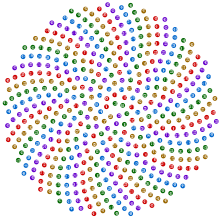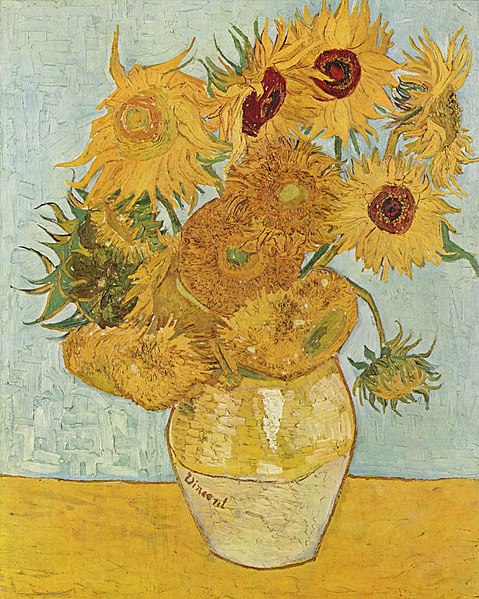Sunflowers are big showy blooms, seeing a large field of them is a memorable experience.
The flowers face in the same direction, east, as if worshiping the rising sun. It is a popular misconception that sunflowers move with the sun.
Though the Sunflower starts as a smallish seed it can grow to be a giant. I think this is a much more appropriate plant for the "Jack in a bean stalk" story than a bean, but "Jack in the Sunflower" probably won't replace the classic.
The flower heads start out as a large tightly closed bud and slowly open to reveal first the petals and then the flowers.





The flowers are pollinated and form into seeds and the head becomes heavier and begins to droop.




This one appears to be shading its "face" from the sun:



The flowers face in the same direction, east, as if worshiping the rising sun. It is a popular misconception that sunflowers move with the sun.
"A common misconception is that sunflower heads track the Sun across the sky.[8] This old and chronic misconception was debunked already in 1597 by the English botanist John Gerard, who grew sunflowers in his famous herbal garden: "[some] have reported it to turn with the Sun, the which I could never observe, although I have endeavored to find out the truth of it."[7] The uniform alignment of sunflower heads in a field might give some people the false impression that they are tracking the sun, but the heads are actually pointing in a fixed direction (East) all day long."
"That is why blooming (and faded) flowers of the sunflower are living compasses (however not too exact): West is behind, North to the left, and South to the right. This is true for open space only." (Wikipedia)
 |
| A field of Sunflowers growing in France |
"Sunflower (Helianthus annuus) is an annual plant native to the Americas. It possesses a large inflorescence (flowering head). The sunflower is named after its huge, fiery blooms, whose shape and image are often used to depict the sun. It has a rough, hairy stem, broad, coarsely toothed, rough leaves and circular heads of flowers. The heads consist of many individual flowers which mature into seeds, often in the hundreds, on a receptacle base."
"From the Americas, sunflower seeds were brought to Europe in the 16th century..." The plant was cultivated from the seeds .. "along with sunflower oil, they became a widespread cooking ingredient."
"Leaves of the sunflower can be used as cattle feed, while the stems contain a fibre which may be used in paper production." (Wikipedia)
Though the Sunflower starts as a smallish seed it can grow to be a giant. I think this is a much more appropriate plant for the "Jack in a bean stalk" story than a bean, but "Jack in the Sunflower" probably won't replace the classic.
The flower heads start out as a large tightly closed bud and slowly open to reveal first the petals and then the flowers.





The flowers are pollinated and form into seeds and the head becomes heavier and begins to droop.


The flowers and seeds form a spiral pattern, a form of Fermat's Spiral, and it turns out there is a bit of mathematical magic here:
Here is an excerpt from Wikipedia to explain:
Mathematical model of floret arrangement

Illustration of Vogel's model for n=1 ... 500
"A model for the pattern of florets in the head of a sunflower was proposed by H. Vogel in 1979. This is expressed in polar coordinates
where θ is the angle, r is the radius or distance from the center, and n is the index number of the floret and c is a constant scaling factor. It is a form of Fermat's spiral. The angle 137.5° is related to the golden ratio (55/144 of a circular angle, where 55 and 144 are Fibonacci numbers) and gives a close packing of florets. This model has been used to produce computer graphics representations of sunflowers."

This one appears to be shading its "face" from the sun:

"The evidence thus far is that the sunflower was first domesticated in what is now the southeastern US, roughly 5000 years ago.,[12] and possibly introduced into Mexico at an early date, as other crops such as maize were exchanged. The earliest known examples of a fully domesticated sunflower have been found in Tennessee, and date to around 2300 BC. Many indigenous American peoples used the sunflower as the symbol of their solar deity, including the Aztecs and the Otomi of Mexico and the Incas in South America. In 1510 early Spanish explorers encountered the sunflower in the Americas and carried its seeds back to Europe.[13] Of the four plants known to have been domesticated in what is now the continental United States (marshelder (Iva annua), chenopod (Chenopodium berlandieri), squash (Cucurbita pepo), and sunflower (Helianthus annuus)) to have become an important agricultural commodity, sunflower is currently the most economically important."
"During the 18th century, the use of sunflower oil became very popular in Russia, particularly with members of the Russian Orthodox Church, because sunflower oil was one of the few oils that was allowed during Lent, according to some fasting traditions." (Wikipedia)


Sunflowers are (from Wikipedia):
- the state flower of the US state of Kansas, and one of the city flowers of Kitakyūshū, Japan.
- often used as a symbol of green ideology. The sunflower is also the symbol of the Vegan Society.
- during the late 19th century, used as the symbol of the Aesthetic Movement.
- the subject of Van Gogh's most famous series of paintings, Sunflowers (one version below)
- the national flower of Ukraine.
- chosen as the symbol of the Spiritualist Church for many reasons, but mostly because it turns toward the sun as "Spiritualism turns toward the light of truth". Modern Spiritualists often have art or jewelry with sunflower designs.
- from February 2010, painted on part of Kuban Airlines of Russia's fleet in a new livery featuring enormous flowers.
 |
| one version of Vincent Van Gogh's Sunflowers series |
I am painting a picture of sunflowers too, but I don't dare share the stage with Vincent, so I will show that another time.
Thank you for dropping by, a very happy Whimsy Wednesday to you, until next time .............











That got me thinking. Good job I'd already enjoyed a very wet walk.
ReplyDeleteFibonacci, a fascinating subject. I seem to remember that the spiral on a snail shell also follows this ratio.
I'll have to go now and start drawing little squares and connecting corners.
Gillian, beautiful post on the sunflowers. It is an wonderful experience to see a field of them. I loved your photos and the Van Gogh's sunflower. I will look forward to seeing your sunflower painting. Have a great day!
ReplyDeleteThose are gorgeous shots of the sunflowers! Nice work!
ReplyDeletei knew about the fibonacci series in sunflowers. they're just amazing. :)
ReplyDeleteI just love the sunflower. It's one of my favorite flowers. But I must admit I did not know about its history till today. I always love reading your blog.
ReplyDeleteCan't wait to see your painting.
Hugs~
There's something magical about sunflowers, for sure. I cannot pass one without wanting to photograph it. :)
ReplyDeleteOne of my favorite flowers to photograph, these are really beautiful!
ReplyDeleteYour sunflower shots are utterly gorgeous.
ReplyDeleteSunflowers, ah, I do love them, and I love the spiring effect on the seeds. Your photos are fantastic, and, put the painting of yours, it won't spoil them together.
ReplyDeleteI love sunflowers. Beautiful shots of them and an interesting post.
ReplyDeleteBeautiful big showy flowers. I especially like your series of photos showing the development of the flowers.
ReplyDeleteThat shot of sunflowers in France doesn't look real.......it's like a painting:) Beautiful. I love them because they add color punch to the garden and then can serve as food for birds or um....us:) Very pretty pics:) And a splash of yellow makes everyone happy:)
ReplyDeleteThat was very interesting, I had no idea that they didn't move at least a little...
ReplyDeleteWe had a long row of them about a 1/4 mile planted in the fields at the farm...so beautiful.
All facing the same way.
Jen @ Muddy Boot Dreams
I love the sunflower and you have captured them so beautifully!
ReplyDeleteSunflowers are favourites with me and I enjoyed seeing all the closeups you've taken. Thanks for stopping by again - have a good week!
ReplyDeleteWell that's a lot of information about one little (or not so little) flower. I knew Fibonacci's formulas got involved in some graphs of activity in the stock market, but I sure didn't know about sunflowers. Great job on all that research and more importantly (to me at least) great shots.
ReplyDeleteSunflowers are a favourite of mine. Love photographing them. Great shots!
ReplyDeleteWow, what a magnificent post filled with gorgeous sunflower photographs and interesting information. I learned so much from reading this. I'm looking forward to planting some sunflower seeds on our property next year. I hope to take photographs even half as lovely as yours, Gillian! Always a pleasure to stop by and read your marvelous blog!
ReplyDeleteAnd there are so many varieties of them. But my favourites are still the tall ones with the fat faces.
ReplyDeleteA woman who used to live in our village would show up at her friends' houses at the beginning of summer with sunflower seedlings to put in their gardens every year. And of course whenever we looked at their sunny faces, we'd think of her.
Oh my...I thank you for all this information!
ReplyDeleteWe do have some here in Portugal, in the provinces of Alentejo, and Algarve.
xoxo
BShell
sunflowers are so beautiful ! we have
ReplyDeleteto wait the spring now !
wish you a happy weekend
I LOVE the sunflower! Such lovely photos and wonderful information about this beauty. Can't wait to see your sunflower painting!
ReplyDeleteWow! There was so much information that was new to me in this post, Gillian! What a rich post! Even though I've been eating a vegan diet for almost 10 months, and a vegetarian one for 40+ years before that, I had no idea that there is a World Vegan Day. I didn't even know that sunflowers face East and I had never heard of the spiral ratio. Loved your photographs too. So many beautiful details.. I wish i had some talent for drawing or painting. I'll be looking forward to your painting when it is ready. And.. yes, of course, I'm happy if you want to paint any of my photographs. A small credit as you have done with the others is much appreciated, but mostly, I just love to see what you do with them.
ReplyDeleteHi there - great post - I have to admit that I thought that they tracked the Sun - oh well now I know!
ReplyDeleteStewart M - Australia
I love sunflowers. They make me feel cheerful, but when I see the fields of sunflowers, I feel a bit sad because I am reminded of the film Sunflower starring Marcello Mastroianni and Sophia Loren.
ReplyDelete